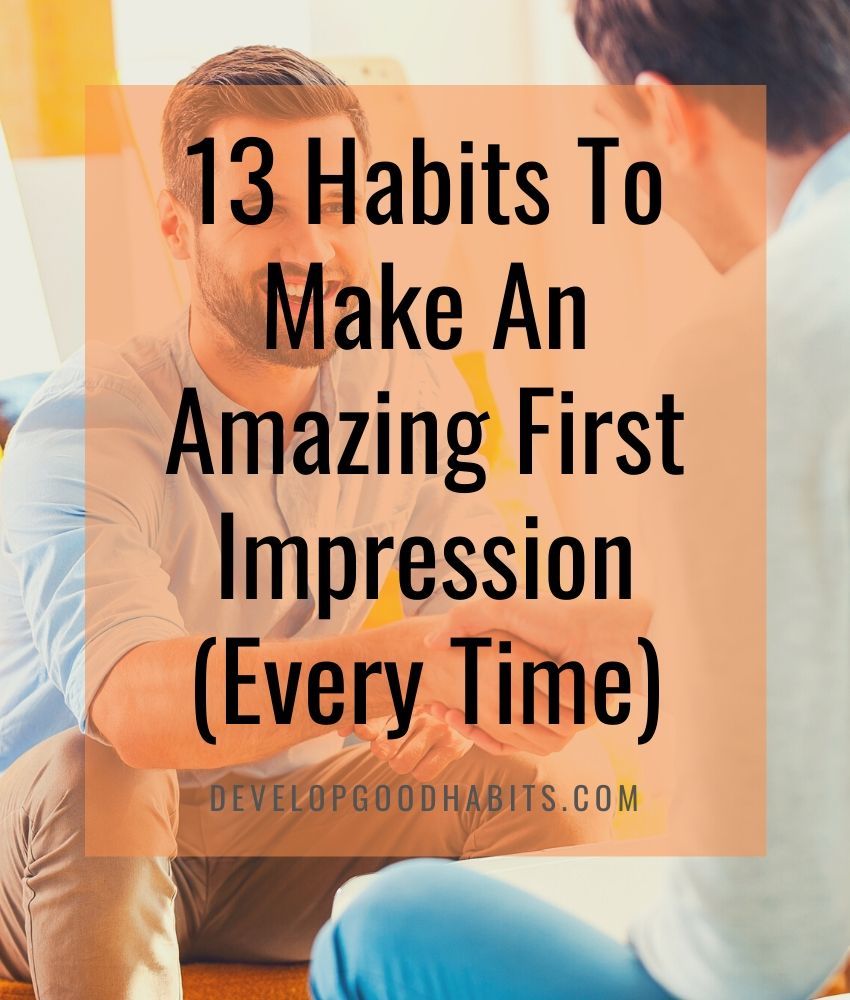There might be affiliate links on this page, which means we get a small commission of anything you buy. As an Amazon Associate we earn from qualifying purchases. Please do your own research before making any online purchase.
On Develop Good Habits we’ve covered a number of topics when it comes to forming positive habits, but we rarely talk about how your routines can improve your social life. That’s why today I’ve invited Charlie Houpert of Charisma On Command to provide a list of habits that can help make a positive first impression when meeting people. Let’s get to it…
Ever wonder why some people just seem to be universally adored?
You know the type. They walk into a party and are an instant hit. They sit down for an interview and become the immediate front runner for the job. Even the testy in-laws love them after the first dinner together. They seem blessed with an innate charm and charisma.
The good news for the rest of us who weren’t born social geniuses is that ANYONE can learn to consistently make an amazing impression. You don’t need to be born with some X factor.
The Importance of First Impressions
But why do first impressions matter so much?
Simply put, they lay the foundation for how others perceive us and, in turn, how we perceive them. They can impact our personal and professional relationships, shape our opportunities, and even affect our self-esteem.
So, it’s not just about making a good impression for the sake of it; it’s about seizing the power of first impressions to navigate life’s myriad situations with confidence and success.
In essence, by recognizing their importance and striving to make positive first impressions, you unlock the keys to building lasting connections, fostering trust, and opening doors to a world of opportunities.
In this post, we’ll discuss insights and tips on building good habits that will help you create an amazing first impression every time.
From body language and communication skills to genuine authenticity and personal grooming, these habits aren’t just about surface-level charm; they’re about building meaningful connections and leaving a positive mark wherever you go.
Just like with any good thing, learning how to make a good first impression takes practice. The video below explores 5 simple daily habits that will help you make consistent, constant improvements throughout your life.
Habit #1: Smile any time you walk into a room or begin a conversation.
First impressions are formed in 7 seconds. That’s before you have a chance to say much of anything. So what are people forming those impressions from?
Your attitude. Which is primarily conveyed by your smile (or lack thereof).
Keep in mind, smiling doesn’t mean just baring your teeth. The genuine Duchene smile engages the muscles around the eye. This is the smile you want to mark your first impression.
Smiling also has the added benefit of releasing dopamine into your system. So you will actually feel happier and free you from stress. That virtuous cycle can make all the difference in making an impression.
Habit #2: Open your body language.
In unfamiliar situations, you might have a tendency to close off. To cross your arms, lower your chin, and make yourself smaller.
You might also feel inclined to grab a drink at a bar or networking event so that you can wield it like a shield, holding it high at your chest even when you aren’t drinking. This closed body language sends the message loud and clear: not available for interaction. This will always make a bad first impression.
Instead, open up. Uncross your arms, lift your chin, and place your feet a bit wider than your shoulders. The physical act of opening your body will actually make you feel more social, much like smiling will make you feel happier. Other people will also pick up on those cues and feel drawn to you.
Habit #3: Don’t wait to be introduced.
We’ve all been there. You’re walking down the street or out at an event and the person you’re with bumps into some friends. Then you stand there awkwardly while they catch up for three minutes.
No more! When you’re thrown into close quarters with other people or have a friend in common or are just at the same party, take the initiative to introduce yourself. You immediately make everyone feel more comfortable since you’re all part of the conversation.
Habit #4: Use people’s names.
As Dale Carnegie said, “a person’s name is to that person the sweetest and most important sound in any language.” Remember people’s names and they’ll immediately like you.
A great way to remember names AND generate goodwill is by make a habit of quickly saying someone’s name back to them.
So when you find out a guy is named John you can follow up with, “So what brings you here today, John?” Or “Nice to meet you John!” Saying someone’s name out a loud a few times really makes it stick.
Habit #5: Develop a fascinating way to answer, “Where are you from?”
You’re going to be asked, “Where are you from?” about ten million times over the course of your life. Think it might be a good idea to have an interesting response?
No, I don’t mean to invent some story about how you were born in Antarctica and raised in Monaco. I mean to share something about yourself. Let them know something that evokes emotion. Let them know about your values. That’s what people care about anyway
So instead of answering “Philadelphia,” you might give them a quick insight into why you currently live where you do.
So you’d say: “I am from Philadelphia, but I actually moved out here to Cali because I love the laid back style of life. There is nothing I love more than spending a beautiful day outside the beach with friends.”
Habit #6: Develop a fascinating way to answer, “What do you do?”
The same principle applies to “What do you do?” Most people don’t know what a “private equity analyst” or a “corporate trainer” is.
Even if you took 5 minutes explained your job, they’d probably remain confused because chances are they don’t work in your industry. And who wants to talk about work that long anyway?
Instead of just answering with your job title, get in the habit of sharing WHY you chose your job or what you like about it. So you might say, “I’m a private equity analyst.
I like to geek out over numbers and it is really crazy to see how the quantitative work I do on a spreadsheet winds up impacting people’s lives.” An answer like that gives the other person something to relate to instead of just allowing a conversation to stall.
Habit #7: Ask better questions than “Where are you from?” or “What do you do?”
When you ask, “Where are you from?” or “What do you do?” you get a generic answer. “Calgary.” “Stockbroker.” If you’ve never been to Calgary and you don’t know any stockbrokers the conversation dies. Right then and there.
Instead, dig deeper. Not just into the logistical details. Ask people if they like their jobs or hometowns. Find out what fires them up.
We all come from different places and on the surface, our jobs are often completely unrelated to one another’s.
But when you get into underlying motivations of why we move cities and why we pick professions, we’re all remarkably similar. This is the level of conversation where you can actually relate and connect with people.

Habit #8: Look people in the eye while YOU speak.
Most people find it easy to look at others in the eye when listening. But when it comes to their turn to speak, their eyes go wandering. They look at the floor, the ceiling, anywhere but into the eyes of the person who is listening.
Bill Clinton was renowned for his laser eye contact when he spoke. He would look his listener in the eye. That person would know they had his full attention. They often described feeling like, “they were the only person in the room.” Look people in the eye while you speak and you’ll captivate them.
Habit #9: Don’t scan the room or check your phone while listening.
No one likes feeling like you’d rather be somewhere else when you’re with them. Yet that is exactly how you make other people feel when you scan a room or check your cell phone while someone is speaking to you.
If you need to get a look around the room, do so in between conversations. At the very least, let the person you’re speaking to know you’re looking for someone.
Put your cell phone on silent whenever you want to make a good impression. You won’t be tempted to answer random texts or calls. After all, how often is it that something can’t wait 10 minutes?
Habit #10: Speak louder.
Oftentimes when we get around people we’d like to impress, we shrink. In order to avoid making a bad impression, we try to make no impression at all. And the first casualty is the volume of our voice.
Speak like you’re meant to be heard, especially when you’re nervous. Using a strong voice will jolt you out of your nerves and will demonstrate confidence to the people around you. It’s okay to be in over your head. It’s not okay to use that as an excuse for undercutting everything you say by whispering.
Habit #11: Keep your inflection down when making statements.
In the same situations where you might be tempted to whisper, you’re also likely to constantly speak like you’re asking a question. You’ll say the last word of every sentence in a higher pitch. Almost like you’re asking permission for the right to speak.
While an upward inflection is appropriate for questions, it makes all of your statements sound halfhearted. Like you don’t even believe in them. Take special care to speak in a way that communicates conviction (i.e., downward or neutral inflection at the end of your sentences).
Habit #12: Touch people.
Research shows it only takes 1/40th of a second of physical contact for people to feel a bond with one another. So shake hands instead of doing an awkward wave to say hello.
Touch people on the forearm or shoulder when making a point. Clap the back of their shoulder when saying goodbye. You don’t need to be overbearing. With just a few small points of contact, people will take an immediate liking to you.
Habit #13: Bring fun.
Not every conversation needs to have the formality of an interview. Get in the habit of answering every couple of questions in jest. When someone asks who you know at the party, joke that you heard music and just decided to walk in off the street.
Being the first in a conversation to crack a joke makes you the de facto leader. You’ve shown that you don’t always need to appear stuffy and people will adore you for it.
Final Thoughts on First Impressions
Remember, making an amazing first impression isn’t about pretending to be someone you’re not. It’s about showcasing the best version of yourself, making others feel valued and respected, and opening doors to meaningful connections and opportunities.
Be yourself, and remember the power of these habits. Whether you’re meeting new friends, making important business connections, or just engaging with the world around you, let your amazing first impression be a reflection of your authentic self.
Now, if you’re looking to improve your communication skills furthers, these articles might help:
Finally, if you want to take your goal-setting efforts to the next level, check out this FREE printable worksheet and a step-by-step process that will help you set effective SMART goals.




